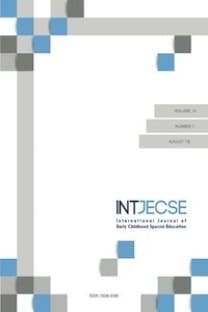Otizmli iki çocukla yoğun gündüz tuvalet eğitimi: Sistematik uygulama ve izleme başarıyı garantiler!
Intensive daytime toilet training of two children with autism: Implementing and monitoring systematically guarantees success!
Intensive toilet training, daytime toilet training, children with autism, toileting problems,
___
Azrin, N. H., & Foxx, R. M. (1971). A rapid method of toilet training the institutionalized retarded. Journal of Applied Behavior Analysis, 4, 89-99.Azrin, N. H., & Foxx, R. M. (1974). Toilet training in less than a day. New York: Pocket Books.
Cicero, F. R., & Pfadt, A. (2002). Investigation of a reinforcement-based toilet training procedure for children with autism. Research in Developmental Disabilities, 23, 319-331.
Cooper, J. O., Heron, T. E., & Heward, W. L. (2007). Applied behavior analysis (2nd ed.). Upper Saddle River, NJ: Pearson.
Keen, D., Brannigan, K. L., & Cuskelly, M. (2007). Toilet training for children with autism: The effects of video modeling. Journal of Development of Physical Disabilities, 19, 291-303.
Kroeger, K. A., & Sorensen-Burnworth, R. (2009). Toilet training individuals with autism and other developmental disabilities: A critical review. Research in Autism Spectrum Disorders, 3, 607-618.
LeBlanc, L. A., Carr, J. E., Crossett, S. E., Bennett, C. M., & Detweiler, D. D. (2005). Intensive outpatient behavioral treatment of primary urinary incontinence of children with autism. Focus on Autism and Other Developmental Disabilities, 2, 98-105.
Lovaas, O. I. (2003). Teaching individuals with developmental delays: Basic intervention techniques. Austin, Texas: Pro-Ed.
Luiselli, J. K. (1994). Toilet training children with sensory impairments in a residential school setting. Behavioral Interventions, 9, 105-114.
- ISSN: 1308-5581
- Başlangıç: 2009
- Yayıncı: İbrahim H. DİKEN
Down sendromlu bireyler konusunda konuşma dili: Yaşam boyu bakış açısı
Otizmli iki çocukla yoğun gündüz tuvalet eğitimi: Sistematik uygulama ve izleme başarıyı garantiler!
Gönül Kırcaali-İftar, Burcu ÜLKE-KÜRKÇÜOĞLU, Özlem Çetin, Editörden, Emre Ünlü
Erken çocukluk özel eğitimi için program yöneticisi rehberi
Otizm spektrum bozuklukları olan küçük çocuklar için kapsayıcı bir program planlama
Brenda Smith Myles, Barry G. Grossman, Ruth Aspy, Shawn A. Henry
Avusturya'da erken çocukluk müdahalesi: 30 yıllık gelişime genel bir bakış ve gelecekteki zorluklar
Özel desteğe gereksinimi olan çocukların eğitim desteği hakkından öğretmenlerin görüşleri
